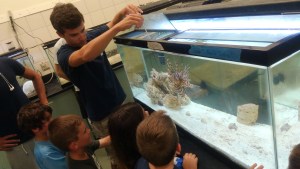NOAA Teacher at Sea
Martha Loizeaux
Aboard NOAA Ship Gordon Gunter
August 22 – 31, 2018
Mission: Summer Ecosystem Monitoring Survey
Geographic Area of Cruise: Northeast Atlantic Ocean
Date: August 30, 2018
Weather Data from the Bridge
- Latitude: 39.115 N
- Longitude: 74.442 W
- Water Temperature: 26.4◦C
- Wind Speed: 11.7 knots
- Wind Direction: SW
- Air Temperature: 28.2◦C
- Atmospheric Pressure: 1017.03 millibars
- Depth: 22 meters
Science and Technology Log

As we wind down this cruise and start packing up all the gear, I find myself reflecting on all I’ve learned while acting as a Teacher at Sea. Tomorrow I’ll watch my last sunrise on the deck of NOAA Ship Gordon Gunter and it has truly been a once in a lifetime experience. Here are some of the lessons I’ll take away:
- The ocean is huge and filled with so much life, it is hard to comprehend.
- The actions of humans all over the world are so impactful, they are changing the basic ecosystem functions in the sea.
- Scientists are doing SO MUCH more than I ever knew or ever will fully know.They have discovered more than most of us understand.The ones I have been spending time with are inquisitive, intelligent, and open to sharing what they know.Find a scientist and ASK lots of questions!
- There are a lot of salps out there.
- Satellites are cool and tell us A LOT of information.
- LIGHT is an incredible thing.It allows life to exist.It moves and changes and bounces and bends and scatters in thousands of different colors, many of which our eyes can’t see.By studying what light is doing we can learn all kinds of things about what’s happening on Earth.
- Plankton is cool.So is science.
- Everything on our Earth is the way it is because of water and light.Surround yourself with both and you will feel connected to everything.
- There are a lot of salps out there.
I know that after this journey I will continue to ask a lot of questions, research and explore what is happening in the scientific world, and connect my students to it as well. I hope I have inspired you to explore and wonder.
A little interview with the Deck Department

There are still lots of people on this ship who I have not interviewed, and I wish I had time to interview them all! But I did want to shed light on the Deck Department of the ship. These are the people who are the backbone of all of the ship’s daily tasks. They assist with every aspects of the ship’s operation, including navigation, sanitation, maintaining equipment, deploying scientific gear, and more. While waiting for the plankton nets to tow at our stations, I had the opportunity to ask some members of the Deck Department a few questions. Thanks Steve, Jeff, John, and Jerome (our Chief Bosun)!
Me – What would you be doing if you were not working for NOAA?
Steve – I have no idea.
Jeff – web development or traveling
John – I used to be a bricklayer
Jerome – I almost became a highway patrolman
Me – Do you have an outside hobby?

Steve – I dabble in the stock market and current affairs. I also love stargazing.
Jeff – piano, photography, and backpacking
John – I used to be on two softball leagues.
Jerome – time with family
Myself, the other volunteers, and the Deck Department had many a brief chat while waiting for the plankton nets or the CTD. We talked about financial decisions, travel locations, and life at sea. Thanks for keeping the ship operations running smoothly Deck Department!
Personal Log
I am looking forward to seeing a new city tomorrow from the perspective of the ship as we head in to port in Norfolk, VA, where I will catch a plane to fly home. It will be a bittersweet ending to an amazing experience. I am definitely looking forward to seeing my family and sharing stories at home. I am inspired to get out on the water more and become more involved in the local science happening around my home in the Florida Keys. I will miss the expansive view of water and sky and the constant learning that I have experienced on NOAA Ship Gordon Gunter. But I am inspired and excited and ready to head home!

Did You Know?
We saw two leatherback sea turtles today! The leatherback is the largest of all living turtles and is the fourth heaviest reptile (some crocodilians are heavier). They get so huge on a diet of only jellyfish!

DO Try This At Home
Do you live near the water? You can make your own plankton net and tow for plankton. You’ll need a nylon stocking and a clean peanut butter jar. Cut the foot off of the stocking and cut a circle out of the top of the jar. Fit the ankle of the stocking over the top of the peanut butter jar and screw on the lid so that the hole in the lid faces into the stocking. Now you have a basic plankton net. Drag your net through the water, allowing the water to flow into the net and into the jar. After a couple of minutes, look in your jar. Do you see any tiny critters moving around? That’s plankton! Make sure you release your plankton after you get a good look at it.





































































